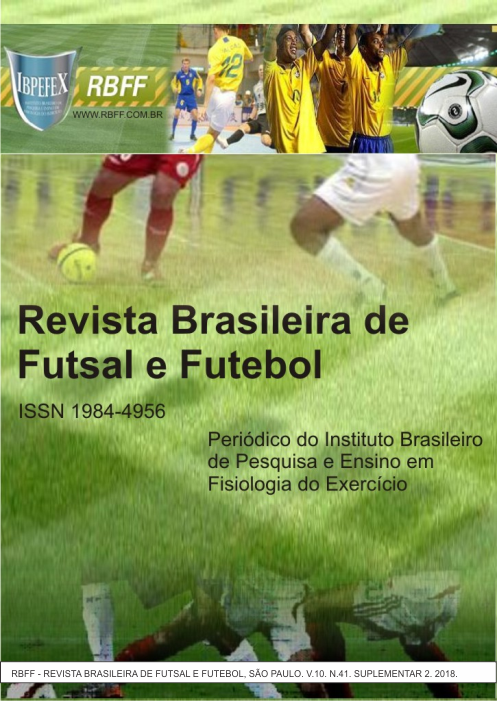Analysis of the incidence of counterattacks in the futsal of the Corinthians team under 20 category state champion 2016
Abstract
Futsal is one of the most popular sports in Brazil, however it is still the sport that less occurs sharing technical, tactical, and strategic among their supporters in the country, starting from this principle the present study aimed to analyze quantitatively the offensive plays of the counter-attacks of the team sub 20 Corinthians. Were observed in fourteen matches of the State championship 2016 and used the collection of data by means of videos taken from youtube. The variables used to configure the sources of the goals of the counter-attack were: The sector in which the ball was stolen, the characteristics of the counter-attacks, the zone of completion and the enjoyment of finishing. In total there have been 83 goals scored, 28 goals (34%) were from counter-attacks, of those 28 goals, 17 were made in the qualifying round and 11 goals scored in the final stage. There was a higher Incidence of the output of the counter-attack in the central areas of the defense SDC1 (16%) and SDC2 (21%), it was possible to report a greater tendency of the team to adopt the counter-attack assisted by the player in line, an average of 6.5 per game in the first stage and 5.3 in the final phase. Has been identified an index of utilization of the completions in the goal after a counter-attack of 30% and completions were completed in their vast majority in the central zone offense
References
-Alves, I. P.; Bueno, L. Analise dos gols na primeira fase da liga futsal 2012. Revista Brasileira de Futsal e Futebol, São Paulo. Vol. 4. Num. 12. 2012. p. 118-123. Disponível em: <http://www.rbff.com.br/index.php/rbff/article/view/135>
-Andrade, M. X. Futsal: Inicio, Meio e Finalidade: Noções sobre preparação física, tática e técnica. Marechel Cândido Rondon -PR: 2013.
-Barrena, A. D. S. Análise dos contra-ataques da equipe do Corinthians na categoria adulto e sub 20 no ano de 2013. Revista Brasileira de Futsal e Futebol. São Paulo. Vol. 7. Num. 26, 2015. p. 375-381. Disponível em: <http://www.rbff.com.br/index.php/rbff/article/view/352>
-Bello Junior, N. A ciência do esporte aplicada ao futsal. Rio de Janeiro.Sprint.1998.
-Bolsonaro, J. R. Análise das finalizações na fase final da liga futsal 2012. Revista Brasileira de Futsal e Futebol. São Paulo. Vol. 7. Num. 24. 2015. p. 148-152. Disponível em: <http://www.rbff.com.br/index.php/rbff/article/view/276>
-Cavalcanti, K. G. R. Incidência dos contra-ataques da associação concordiense de futsal na liga nacional. Revista Brasileira de Futsal e Futebol. São Paulo. Vol. 7. Num. 26. 2015. p. 408-412. Disponível em: <http://www.rbff.com.br/index.php/rbff/article/view/361>
-Fukuda, J. P. S.; Santana, W. C. D. Análises dos gols em jogos da liga futsal 2011. Revista Brasileira de Futsal e Futebol, São Paulo. Vol. 4. Num. 11. 2012 p. 62-66. Disponível em: <http://www.rbff.com.br/index.php/rbff/article/view/125>
-Gimenes, S. V.; Canciglieri, P. H.; Braz, T. V.; Thiengoet, C.S. Modelação das ações de contra-ataque em partidas da FIFA World Cup 2006. Revista Brasileira de Futsal e Futebol. São Paulo. Vol. 5. Num. 15. 2013. p. 3-14. Disponível em: <http://www.rbff.com.br/index.php/rbff/article/view/159>
-Giusti, M.L.; Ballen, J. L.; Nervo, S.; Navarro; A. C. A importância e a origem os gols de 2ª trave no futsal: um estudo de caso da equipe profissional da Universidade Católica de Pelotas -UCPel. Revista Brasileira de Futsal e Futebol. São Paulo. Vol. 3. Num. 7. 2011. p. 75-78. Disponível em: <http://www.rbff.com.br/index.php/rbff/article/view/80>
-Istchuk, L. L.; Santana, W. C. Futsal feminino de alto rendimento: comportamento tatico-tecnico da transicao defensiva. Revista Brasileira de Futsal e Futebol, São Paulo. Vol. 4. Num. 14. 2012. p. 288-293. Disponível em: <http://www.rbff.com.br/index.php/rbff/article/view/170>
-Marchi, R. V. Silva, C. E. O.; Scramin, L. R. R.; Teixeira, A. A.; Chiminazzo J. G. C. Incidência de gols resultantes de contra-ataques de equipes de futsal. Conexões. Vol. 8. Num. 3. 2010. p. 16-23.
-Medina, Á. J. Lorente, V. M.; Felipe, A. G.; Artal, A. P. Análisis observacional de los goles de das temporadas de la LNFS. Rev. Int. Med. Cienc. Act. Fís. Deporte. Vol. X. Num. X. 2016. p. 1-16.
-Ré, A. N. Características do futebol e do futsal: implicações para o treinamento de adolescentes e adultos jovens. http://www.efdeportes.com/ Revista Digital. Buenos Aires. Vol. Año 13. Num. 127. 2008. p. 1-1.
-Santana, W. C.; Garcia, O. B. A incidência do contra-ataque em jogos de futsal de alto rendimento. Pensar a Prática. Vol. 10. Num. 1. 2007. p. 153-162.
-Santos, R. S. Análise dos gols em contra-ataque na Copa da UEFA de futsal 2010. Revista Brasileira de Futsal e Futebol. São Paulo. Vol. 2. Num. 6. 2010. p. 171-178. Disponível em: <http://www.rbff.com.br/index.php/rbff/article/view/64>
-Silva, G. P. P.; Siqueira, L. G.; Navarro, A. C. Quantificação da incidência e eficiência dos contra-ataques da equipe do Grêmio recreativo Barueri categoria sub 20 no campeonato estadual de futsal 2008. Revista Brasileira de Futsal e Futebol. São Paulo. Vol. 2. Num. 5. 2010. p. 72-76. Disponível em: <http://www.rbff.com.br/index.php/rbff/article/view/46>
-Thomas, J. R.; Nelson, J. K.; Silverman, S. J. Métodos de pesquisa em atividade física. Porto Alegre. Artmed. 2012. p. 400.
Authors who publish in this journal agree to the following terms:
- Authors retain the copyright and grant the journal the right of first publication, with work simultaneously licensed under the Creative Commons Attribution License BY-NC which allows the sharing of the work with acknowledgment of the authorship of the work and initial publication in this journal.
- Authors are authorized to enter into additional contracts separately for non-exclusive distribution of the version of the work published in this journal (eg, publishing in institutional repository or book chapter), with acknowledgment of authorship and initial publication in this journal.
- Authors are allowed and encouraged to post and distribute their work online (eg, in institutional repositories or on their personal page) at any point before or during the editorial process, as this can bring about productive change as well as increase impact and impact. citation of published work (See The Effect of Free Access).





